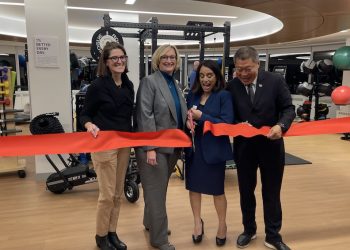The Federal Reserve”™s decision to raise its benchmark interest rate on Dec. 14 ”“ the second such increase in a year and only the second, too, since December 2008 ”“ drew mixed reactions nationwide from banking and economic experts. Many saw it as an encouraging sign of an ongoing, if slow, national economic recovery, while others viewed it as possibly lessening both banks”™ profitability and consumers”™ interest in and ability to afford loans.
But Connecticut area banks, which collectively were on pace to post strong results for 2016, maintain that the Dec. 14 rate increase – from a range of 0.25 to 0.5 percent to a range of 0.5 to 0.75 percent – is small enough to not have an adverse effect. Further, they said that expected additional increases this year ”“ likely two or three ”“ should not noticeably dampen business.

“In my estimation, two increases feel more likely than three,” said Newtown Savings Bank CFO William J. McCarthy. “And those would be modest, not skyrocketing.”
“There could be a rate increase or two this year,” said Timothy Bergstrom, senior vice president and head of business banking for Connecticut at Webster Bank in Hartford. “But the end result would still be very affordable to businesses and consumers alike.”
“People are increasingly feeling that we”™re normalizing again,” Bergstrom said. “A moderate increase or two shouldn”™t change that.”
According to the Federal Deposit Insurance Corp., the 42 Connecticut banks it insures accrued a collective $562 million in profits through the first nine months of 2016, a nearly 8.1 percent increase from the $520 million posted by 43 banks for the same period in 2015. (Naugatuck Valley Savings & Loan was acquired by Liberty Bank in January 2016.)
Through three quarters, total assets grew year-over-year by nearly 7.1 percent, from $97.1 million fo the first three quarters of 2015 to $104 million for the first nine months of 2016. Loans and leases at FDIC-insured Connecticut banks during the same period rose some 7.6 percent, from $69.8 billion to $75.1 billion.
With those numbers, banks are entering 2017 feeling confident, dismissing fears that higher rates could negatively affect their profitability.

“In most cases, as rates go up, profitability goes up,” said Newtown Savings President and CEO John Trentacosta. “When you”™re in the banking industry, you”™re hampered by having low rates for as long as we have. You need to figure out a way to make money in that environment.
“Of course,” he added, “if rates go up a lot, that could slow things down.”
Homeowners may feel the greatest impact. While mortgage rates have been low for several years, as of Jan. 4 the average rate on a 30-year, fixed-rate mortgage was 4.23 percent ”“ the highest since April 2014 and well above the 2016 average of 3.65 percent.
“On the residential side, any potential borrowers who have been on the sidelines waiting to make a purchase should try to lock in now,” McCarthy advised. “Fence-sitters should take advantage now, before the rates go up any more.”
Fairfield County bankers said they are most concerned about the small business segment.
“We will continue to focus on small businesses this year,” said Michael Weinstock, Connecticut market president at M&T Bank. “Even though we”™ve lost an amount of small business jobs here, there are signs that small businesses could have a number of opportunities, given the development happening in places like Bridgeport and the bigger cities in Connecticut, as well as in Stratford and some of the smaller communities.”

At Patriot Bank in Stamford, Richard A. Muskus, executive vice president and chief lending officer, noted that if debt services rise incrementally for small businesses, “They will have to make changes to their business model and business planning. Additional rate increases could limit their cash flow to the point where they may not be able to hire that additional person or be in a position to borrow money for equipment or another store.”
“Should a small business owner be expanding or contracting in this environment? Only the individual business owner knows for sure,” Muskus said. Taking on additional employees or equipment without the ability to turn it into revenue right away can be especially concerning in light of interest rate hikes, he said.
Muskus said that Patriot is “executing well” on the 21 percent of its overall business that comes via small business loans; he”™d noted earlier that historically just 11 percent of the bank”™s business comes from that sector. He added that one of the bank”™s “target goals” is to become an approved U.S. Small Business Administration lender in the first quarter of this year.
Bankers stressed that in the shifting rate environment, borrowers should maintain close relationships with their bank and loan officers. “On the commercial side, you need to look at your loan maturity date,” said Weinstock. “If you have one year left on your loan, you can get an extension.”
Another possibility is a blended mortgage, which combines the interest rate on an existing mortgage with the rate of a new mortgage to fix a new rate somewhere between the two. Typically the prepayment penalty that comes with a refinance is avoided with a blended mortgage.
Bergstrom said the state”™s ongoing economic instability is sending negative signs on its own. “That”™s something that should be monitored closely,” he said. “Getting our fiscal house in order should be our first priority.”
Meanwhile, just where interest rates are headed this year remains an exercise in speculation.
“If you asked economists over the past 10 years if they thought the interest rate would be rising each year, they”™d say, ”˜Yeah, there are going to be big increases this year,”™” Weinstock said. “It”™s just not predictable.”


















